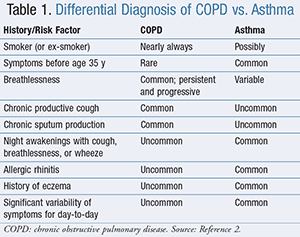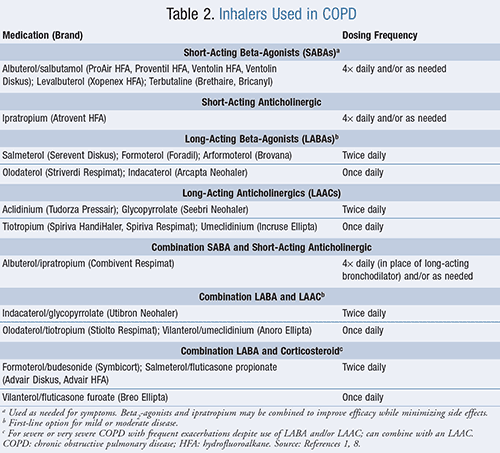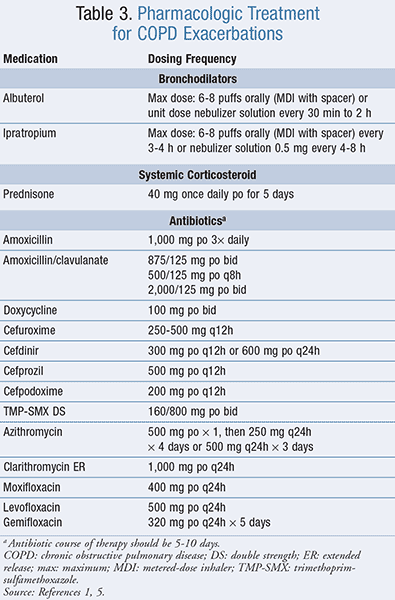US Pharm. 2016;41(7):42-46.
ABSTRACT: Guidelines from the Global Initiative for Chronic Obstructive Lung Disease (GOLD) provide pharmacists and other healthcare professionals with an understanding of chronic obstructive pulmonary disease (COPD) and its treatment options in order to collaboratively manage this progressive disease. The symptoms of COPD can be improved by using both evidence-based pharmacologic and nonpharmacologic treatments. Pharmacists are in an accessible position within communities to counsel patients and answer questions regarding treatment options for COPD. COPD is both a preventable and a treatable disease.
Chronic obstructive pulmonary disease (COPD) is a common respiratory disorder. It is characterized by an abnormal chronic inflammatory response in the airways and lungs due to noxious particles or gases. COPD is a preventable and treatable disease.1 Pharmacists play an integral role in helping the overall treatment and prevention of progression of this disease through patient education.
What Is the Prevalence of COPD?
COPD is the fourth leading cause of death in the world.1 More than 12 million adults are diagnosed with COPD, and it is projected that the disease will be the third leading cause of mortality globally in 2030.2,3 COPD is the only chronic illness that is projected to increase in the coming decades.2
What Are the Symptoms and Risk Factors?
Symptoms of COPD include dyspnea, chronic cough, and chronic sputum production.1 Dyspnea can worsen during exercise or with respiratory infections. Pharmacists can better understand the degree of disease severity by asking patients if they experience any breathlessness during normal day-to-day functions such as walking up a flight of stairs or dressing and undressing themselves. Chronic cough can be present intermittently or daily and may be unproductive.1,2 Chronic sputum production can be any pattern in COPD patients.1
Clinical diagnosis for COPD should be considered in patients who present with these symptoms and have a history of exposure to risk factors. Tobacco smoke, smoke from home cooking and heating fuels, occupational dusts, and chemicals are examples of environmental risk factors.1 Other factors that can potentially increase an individual’s risk of developing COPD include any factor that may affect lung growth during gestation and childhood such as low birthweight and respiratory infections.1 TABLE 1 distinguishes between COPD and asthma.2 In many individuals, the high prevalence of asthma and COPD coexists, resulting in significant airflow limitation and the need for bronchodilators.4

How Is COPD Assessed and Diagnosed?
Therapy is determined based on several factors. Patients should be assessed on their symptoms, degree of airflow limitation, risk of exacerbations, and comorbidities.1
The use of validated questionnaires such as the COPD Assessment Test (CAT) or the Clinical COPD Questionnaire (CCQ) provide a comprehensive assessment of symptoms.1
In order to clinically diagnose a patient with COPD, spirometry testing is required. Forced vital capacity (FVC) is the total amount of air a patient can forcibly blow out after a full inspiration, which assesses lung capacity.2 FEV1 is the amount of air a patient can forcibly blow out in the first second. The ratio of FEV1 to FVC is required for the diagnosis of COPD. The presence of a post-bronchodilator FEV1/FVC <0.70 confirms the presence of airflow limitation; therefore, the patient has COPD.1
Treatment of COPD is based on severity of the disease. The goals of treatment include relieving symptoms, slowing the progression of COPD, improving exercise tolerance, preventing and managing exacerbations, and reducing morbidity and mortality.2
The GOLD Guidelines
Guidelines from the Global Initiative for Chronic Obstructive Lung Disease (GOLD) provide recommendations for the diagnosis, nonpharmacologic and pharmacologic treatment, and management of COPD patients. Their goal is to recommend effective COPD management and prevention strategies for use worldwide. In addition, GOLD objectives include increasing awareness of the medical community, public health officials, and the general public that COPD is a public health problem. Through implementation and evaluation of effective programs for diagnosis and management, COPD morbidity and mortality may be decreased.1
Nonpharmacologic Management of COPD
Smoking Cessation: Pharmacists should encourage COPD patients to stop smoking immediately and recommend medications to help facilitate the discontinuation of smoking. Research has shown that brief counseling of 3 minutes results in quit rates of 5% to 10%.1 Nicotine replacement therapy includes nicotine gum, inhaler, nasal spray, transdermal patch, sublingual tablet, or lozenge. Pharmacologic treatment includes varenicline, bupropion, or nortriptyline. Both nicotine replacement therapy and pharmacologic treatment provide long-term abstinence rates, and these are more effective than placebo. Smoking cessation is one of the most effective strategies that decreases COPD progression, morbidity, and mortality.5,6
Vaccinations: COPD patients should be educated about flu and pneumonia prevention.2 Influenza and pneumococcal vaccines help to decrease the risk of COPD exacerbations and are recommended for all patients with COPD. Infections may trigger 50% to 70% of COPD exacerbations.6 Influenza vaccines should be administered annually. Pneumococcal polysaccharide vaccines are recommended for patients 65 years and older.1
Pulmonary Rehabilitation (PR): This type of therapy decreases hospitalizations, duration of hospital stays, and mortality. PR improves the effect of long-acting bronchodilators, perceived breathlessness, health-related quality of life, and depression and anxiety linked to COPD. Patients must continue with the strategies learned in the PR program because many frequently revert to their baseline within about 2 years after finishing the program. Pharmacists and other healthcare providers can emphasize the importance of continuing to stay active after finishing a 6- to 10-week PR program.1,6
Oxygen and Ventilatory Support: Patients with severe resting hypoxemia and chronic respiratory failure have benefited from long-term administration of oxygen.1 Patients with daytime hypercapnia can be given a combination of noninvasive ventilation with long-term oxygen therapy. In addition, continuous positive airway pressure (CPAP) provides benefits in both survival and risk of hospital admission.1
Occupational Exposure: Emphasize elimination or reduction of exposures to various substances in the workplace that may contribute to COPD exacerbations.1
Indoor and Outdoor Air Pollution: Patients should be cognizant of the air quality depending on their disease severity and avoid rigorous outdoor exercises or remain indoors during pollution episodes.1
Pharmacologic Medications for COPD
Several different types of inhalers, including bronchodilators, inhaled corticosteroids, and combinations, are used in the treatment of COPD (TABLE 2).1,8

Bronchodilators: These medications are integral in the management of COPD symptoms. Inhaled bronchodilators are preferred, and the choice between using anticholinergics, beta2-agonists, theophylline, or a combination product is determined by each individual’s response to therapy and his or her tolerance to adverse effects.
The combination of bronchodilators with different mechanisms of action may improve symptoms and decrease the risk of adverse effects compared to increasing the dose of a single bronchodilator. Bronchodilators may be prescribed on an as-needed or a regular basis to manage symptoms. Long-acting bronchodilators are effective at maintaining symptom relief compared to a short-acting bronchodilator.1 In addition, levalbuterol is not more efficacious when compared to albuterol.5
While both albuterol and levalbuterol can cause paradoxical bronchospasm, cardiovascular effects, immediate hypersensitivity reactions, and hypokalemia, there are some advantages to selecting levalbuterol over albuterol. Levalbuterol is recommended in patients with more severe asthma or COPD and who also require more frequent doses of a beta2-agonist despite correct use of controller medications. In addition, patients with cardiac disease who experience tachycardia with albuterol or with conditions that could worsen with tachycardia such as cardiac arrhythmias, decompensated heart failure, and valvular heart disease may benefit from the use of levalbuterol.11
Inhaled Corticosteroids: COPD patients treated with inhaled corticosteroids benefit from improved symptoms, lung function, and quality of life, and a reduction in the frequency of exacerbations. Long-term use of inhaled corticosteroids is not recommended, as it is also associated with an increased risk of pneumonia and fractures.1,7 Patients may experience exacerbations if they are withdrawn from corticosteroid treatment.1
Combination of Inhaled Bronchodilator and Corticosteroid Therapy: A reduction in exacerbations and improvements in lung function and health status can be seen in moderate-to-severe COPD patients who are on a combi-nation of an inhaled corticosteroid with a long-acting beta2-agonist than either medication alone. However, this combination is also associated with an increased risk in developing pneumonia. The addition of an anticholinergic tiotropium along with a long-acting beta2-agonist and inhaled corticosteroid provides additional benefits.1
Phosphodiesterase-4 Inhibitors: In patients with a history of exacerbations and chronic bronchitis, roflumilast helps to reduce exacerbations treated with oral corticosteroids. There are no comparison studies with inhaled corticosteroids, but there have been beneficial effects when given with long-acting bronchodilators.1
Methylxanthines: This class of drugs is not recommended if long-acting bronchodilators are available and affordable for the patient because they are not as effective or well-tolerated. However, in stable COPD there may be a moderate bronchodilator effect and some symptomatic benefits compared to placebo. The addition of theophylline with salmeterol yields a greater increase in FEV1 and improvement in breathing compared to salmeterol alone.1
Other: Oral corticosteroids are not recommended for long-term treatment of COPD. Antitussives are also not recommended. Mucolytics may be used in patients with viscous sputum with some modest benefits. Nitric oxide is contraindicated in stable COPD.1
Treatment of COPD Exacerbations in the Outpatient Setting
Viral and bacterial respiratory tract infections are the most common causes of an exacerbation of COPD. If purulent sputum is present during an exacerbation, then empiric antibiotic treatment may be started. Spirometric tests are not taken during exacerbations because they are difficult to perform and measurements can be inaccurate.1
Short-acting inhaled beta2-agonists with or without short-acting anticholinergics are preferred for treatment of an exacerbation. The dose and/or frequency of the inhalers should be increased to ensure that treatment needs are met. Systemic corticosteroids work to decrease time to recovery, improve lung function and arterial hypoxemia, and reduce the risks of early relapse, treatment failure, and length of hospital stay. Antibiotics are given if patients present with the following cardinal symptoms: increased dyspnea, increased sputum volume, or increased sputum purulence. They are also given to patients with increased sputum purulence and one other cardinal symptom. Lastly, antibiotics are given to patients who require mechanical ventilation. A summary of these agents is provided in TABLE 3.1,5

The Pharmacist’s Role
It is imperative that pharmacists advise patients on how to properly use their inhalers. Important counseling points for patients with COPD include the following9,10:
• Demonstrate proper techniques with inhaler use. Studies have shown that more than half of patients with COPD use ineffective inhalation techniques when using their inhalers.
• A metered-dose inhaler (MDI) usually requires the patient to breathe in slowly and deeply. Most MDIs require priming and shaking before use.
• A dry-powder inhaler (DPI) requires a quick and deep inhalation to pull the powdered medicine into the lungs. DPIs should not be shaken.
• Review with the patient how to clean the inhaler mouthpiece.
• Remind patients to give themselves enough time to order their next refill so they are not without their medications.
• Some inhalers expire within a certain time frame, so counsel patients to discard any remaining medications past the expiration date.
• Store the inhaler at room temperature. Do not leave the inhaler where it might get too hot or too cold.
• Explain the differences between the various types of inhalers. Bronchodilators relax and open the airways in the lungs. Always use the bronchodilator first before using a steroid inhaler. Steroid inhalers decrease swelling in the airways of the lungs. Rinse out the mouth with water and then spit it out after using the steroid inhaler.
• Stress the importance of medication adherence. A reduction in hospitalization rates and a decrease in mortality have been demonstrated in patients who use their inhalers as prescribed.9,10
Conclusion
Pharmacists play an integral role in managing patients with COPD. Open communication between pharmacists and patients is crucial because studies have shown that patients who feel they are informed and part of the decision-making process are more likely to adhere to a treatment regimen and actively manage their disease.6
REFERENCES
1. Global Initiative for Chronic Obstructive Lung Disease. Global Strategy for the Diagnosis, Management, and Prevention of Chronic Obstructive Pulmonary Disease—2016. http://goldcopd.org/global-strategy-diagnosis-management-prevention-copd-2016/. Accessed March 2, 2016.
2. Intermountain Healthcare. Management of Chronic Obstructive Pulmonary Disease (COPD). 2013 Update. February 2013. https://intermountainhealthcare.org/ext/Dcmnt?ncid=520442593. Accessed March 2, 2016.
3. Lee YM. Chronic obstructive pulmonary disease: respiratory review of 2014. Tuberc Respir Dis (Seoul). 2014;77(4):155-160.
4. Mularski R, Reinke L, Carrieri-Kohlman V, et al. An official American Thoracic Society workshop report: assessment and palliative management of dyspnea crisis. Annals ATS. 2013;10(5):98-106.
5. PL Detail-Document #310508. Improving COPD care. Pharmacist’s/Prescriber’s Letter. May 2015.
6. Amalakuhan B, Adams SG. Improving outcomes in chronic obstructive pulmonary disease: the role of the interprofessional approach. Int J Chron Obstruct Pulmon Dis. 2015;10:1225-1232.
7. Babu KS, Kastelik JA, Morjaria JB. Inhaled corticosteroids in chronic obstructive pulmonary disease: a pro-con perspective. Br J Clin Pharmacol. 2014;78(2):282-300.
8. PL Detail-Document #310107. Inhalers for COPD. Pharmacist’s/Prescriber’s Letter. January 2015.
9. National Heart, Lung, and Blood Institute. Talking with your patients about COPD. www.nhlbi.nih.gov/health/educational/copd/campaign-materials/pub/Talking-with-Your-Patients-about-COPD.pdf. Accessed March 3, 2016.
10. PL Detail-Document #310603. Correct use of inhalers. Pharmacist’s/Prescriber’s Letter. June 2015.
11. Hulisz D. How does levalbuterol (Xopenex) compare with albuterol. www.medscape.com/viewarticle/719008. Accessed June 11, 2016.
To comment on this article, contact rdavidson@uspharmacist.com.





